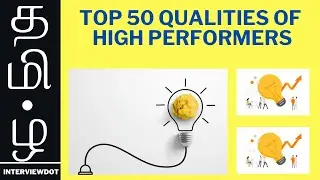TOP 50 QUALITIES OF HIGH PERFORMERS | INNOVATION | CAREER SUCCESS TIPS | PROMOTION| InterviewDOT
Click here - to get notifications.
TOP 50 QUALITIES OF HIGH PERFORMERS | INNOVATION | CAREER SUCCESS TIPS | PROMOTION| InterviewDOT
Innovation for High Performers: Key Strategies to Foster Creativity and Drive Change
Innovation is the lifeblood of progress, and for high performers, it is a critical skill that can set them apart in any field. Whether you’re a student, a professional, or an entrepreneur, the ability to innovate— to think creatively, solve problems, and implement new ideas—can lead to significant achievements and lasting impact. Here are some strategies to cultivate and enhance your innovative abilities.
1. Embrace Curiosity and Continuous Learning
Curiosity is the foundation of innovation. High performers are often characterized by their insatiable desire to learn and explore new concepts. They are not content with the status quo and are constantly seeking to understand how things work and how they can be improved. This mindset drives them to ask questions, seek out new information, and stay updated on trends and developments in their field.
To nurture this curiosity, commit to continuous learning. Read widely, attend workshops, take online courses, and engage with thought leaders in your area of interest. Exposure to diverse ideas and perspectives can spark creative thinking and lead to innovative solutions. Don’t limit your learning to your immediate field; exploring adjacent disciplines can provide new insights and inspire fresh approaches.
2. Cultivate a Growth Mindset
A growth mindset, as defined by psychologist Carol Dweck, is the belief that abilities and intelligence can be developed through hard work, dedication, and perseverance. High performers with a growth mindset view challenges as opportunities to grow rather than obstacles to be avoided. They are not afraid to take risks, experiment, and fail, because they understand that failure is an integral part of the innovation process.
To cultivate a growth mindset, start by reframing how you view challenges and setbacks. Instead of seeing them as failures, see them as valuable learning experiences. Embrace the idea that your capabilities can expand with effort and practice. This mindset will encourage you to take on new challenges and push the boundaries of what’s possible, leading to innovative breakthroughs.
3. Practice Divergent Thinking
Divergent thinking is a cognitive process used to generate multiple ideas and solutions to a problem. It contrasts with convergent thinking, which focuses on finding a single, correct solution. High performers often excel in divergent thinking, allowing them to come up with a wide range of potential solutions before narrowing down to the most effective one.
To practice divergent thinking, challenge yourself to generate as many ideas as possible when faced with a problem. Don’t dismiss any ideas as too wild or impractical—sometimes, the most innovative solutions come from ideas that initially seem outlandish. Brainstorming sessions, mind mapping, and asking “What if?” questions can all help stimulate divergent thinking. Encourage input from others to bring in different perspectives and further expand the pool of ideas.
4. Collaborate and Build Diverse Teams
Innovation thrives in environments where diverse ideas and perspectives come together. High performers understand the value of collaboration and often seek out partnerships with individuals who bring different skills, experiences, and viewpoints to the table. By working in diverse teams, they can combine their strengths and generate innovative solutions that they might not have developed on their own.
To foster innovation through collaboration, actively seek out team members who complement your skills and challenge your thinking. Encourage open dialogue, where all ideas are heard and considered. Be open to feedback and willing to iterate on your ideas based on the input of others. This collaborative approach not only enhances innovation but also builds stronger, more cohesive teams.
5. Take Calculated Risks and Experiment
Innovation often requires stepping into the unknown and taking risks. High performers are not afraid to experiment and try new approaches, even when there is a chance of failure. They understand that innovation is a process of trial and error, and that success often comes after multiple iterations and refinements.
To become more comfortable with risk-taking, start with small, low-stakes experiments. Test new ideas on a small scale before rolling them out more broadly. Learn from the outcomes of these experiments, whether they succeed or fail, and use that knowledge to inform future attempts. Over time, this willingness to experiment and take calculated risks will lead to more innovative solutions and greater overall success.
6. Create an Environment that Encourages Innovation













![TAMIL WHO IS AN INTRPRENEUR ? HOW YOU CAN BECOME AN INTRAPRENEUR [CAREER GROWTH]? SERIES - EPISODE 1](https://pics.providosiki.com/watch/CpQHCww_uIg)

















